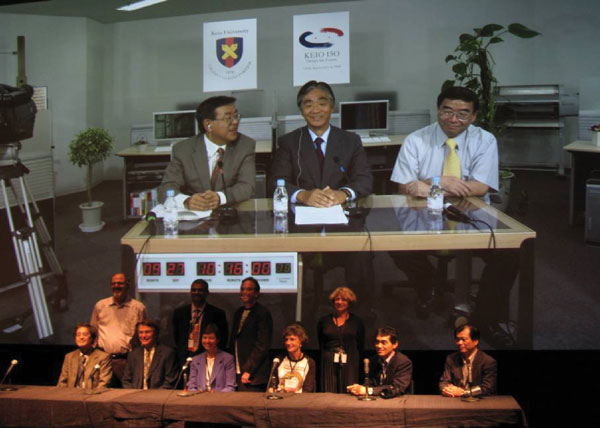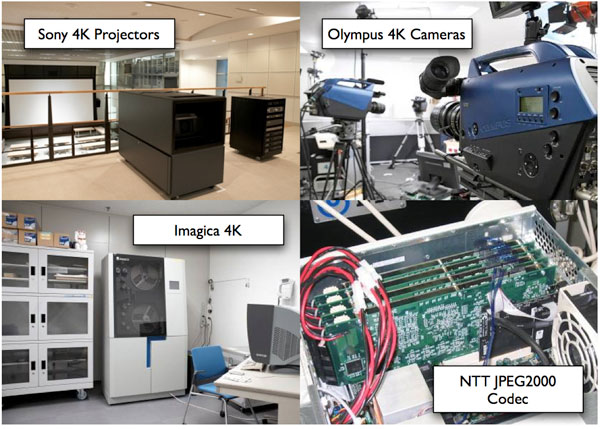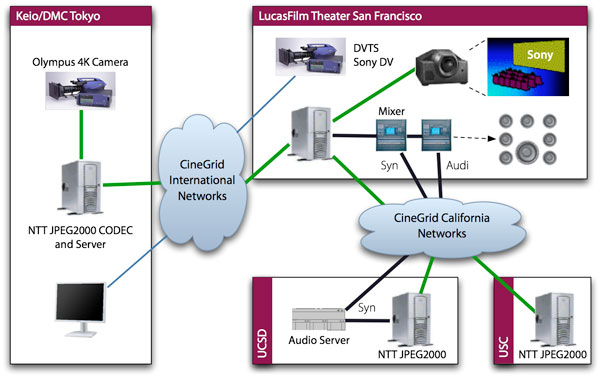
May 2007
|
CineGrid: A New Cyberinfrastructure for High Resolution Media Streaming
|
 May 2007 |
The shared Internet is being used more and more for transmission of digital video data sets. YouTube is distributing 100,000,000 videos every day.1 However, these digital video streams are engineered to be easily transportable over the shared Internet to home users with megabit/sec rates. In contrast, cinema today is still largely shot and distributed in the century-old silver halide medium of film.2 A major barrier holding back the transition of theatrical film to digital distribution is that to preserve the extreme photographic resolution of motion pictures as seen in theatres requires playback bandwidth of a quarter gigabit/sec or more (depending on compression). Cinema is the next step in the ongoing digital conversion of modern media, and it will require building new image-centric hardware/software/networks to facilitate full-resolution human visual and auditory acuity, for production, distribution and, never possible with film, real-time global collaboration.
In addition to its essential role in the creative arts, the film industry has a large economic footprint. For instance, in 2005, the Motion Picture Association of America estimated that movie production provided employment for over 245,000 Californians, with an associated payroll of more than $17 billion.3
Faced with the historic transformation of the global theatrical film business from analog to digital technology, the major Hollywood studios formed the Digital Cinema Initiatives consortium4 to define the technical standards for digital cinema. The two resolutions that have emerged are termed 2K (2048x1080), roughly comparable to the high end of HD, and 4K (4096x2160), with four times the resolution of 2K or high end HD (Fig. 1) and 24 times that of a standard broadcast TV signal. Both standards have 12-bits/color. The digital cinema frame rate is the same 24fps used in analog cinema for DCI-compliant 2K/4K monoscopic “flat” movies, plus a new DCI frame rate of 48 fps (2 x 24fps) for 2K stereoscopic 3D movies.
The uncompressed bandwidth of the 4K format streaming in realtime is ~7.6 gigabits/sec, with each 4K frame having 8.8 megapixels, over twice what is available on the highest end PC monitors and eight times what the normal user has today on their laptop. When compressed using DCI-recommended JPEG 2000 distribution specifications, 4K bit rates to the neighborhood theatre are capped at 250 megabits/sec.
As such, we realized several years ago that 4K digital motion pictures would be one of the most demanding data types for emerging cyberinfrastructure. Since the NSF-funded OptIPuter project5 was well underway, the principle investigators of the OptIPuter at Calit2 and UIC’s Electronic Visualization Laboratory (EVL) initiated a project termed “CineGrid” to apply OptIPuter architectures to the needs of digital media professionals. Our initial collaborative partners were the Research Institute for Digital Media and Content, Keio University (Keio/DMC), the University of Southern California School of Cinematic Arts (USC/SCA) and Pacific Interface, Inc. The complex CineGrid project is overseen by Pacific Interface, which first proposed the CineGrid concept to Calit2/EVL and has subsequently incorporated CineGrid as a new nonprofit membership organization to organize a rapidly growing international research agenda ramping up in the US, Japan, Canada, and Europe.
From inception, CineGrid was conceived as a global effort, with collaborators linked by various national and regional research networks, many of them linked into cooperative peering systems like the Global Lambda Infrastructure Facility (GLIF) to create an international, non-profit testbed for distributed experiments using the highest possible quality pictures and sounds over 1Gbps and 10Gbps photonic networks. We believe CineGrid can stimulate development of new network-centric approaches optimized for digital media production and training/education. We have already seen that CineGrid experiments stimulate very useful testing and refinement of emerging middleware, specialized transport protocols, and collaboration tools, many of which were originally developed for scientific research, visualization, and Grid computing but which can be adapted to the needs of digital media of all types.
CineGrid sets out to define an architecture that enables secure, fast access to the digital media assets at all stages in production, post-production, distribution and archiving. The CineGrid initiative is aligned with four major trends:
Because these are also the trends that drove the invention of the OptIPuter architecture, it is well suited to provide a first working prototype of the cyberinfrastructure needed for a complete digital cinema workflow environment. CineGrid is a new application for the OptIPuter, tailored to meet the special characteristics of networked digital media, particularly the multi-stream 1Gbps and 10Gbps requirements of digital cinema and real-time 4K compressed and uncompressed imagery, and other high quality digital image and audio formats.
We have rapidly found that in addition to the original application of 4K to digital cinema, this super high resolution format is also being adopted by the supercomputer simulation visualization, computer graphics, and scientific imaging communities. Thus, a wide-ranging, multi-disciplinary alliance is emerging to investigate the uses of this new medium. CineGrid enables new kinds of distributed media production, remote mentoring, remote-controlled scientific research, networked collaboration and international cultural exchange. Areas of investigation range from visual special effects for theatrical-quality, digital cinema production to high-resolution scientific visualizations.

The first public demonstration of CineGrid networking was held September 26-29, 2005, at iGrid 2005, an international event hosted at UCSD/Calit2 in conjunction with EVL.6 It featured the world’s first, real-time, international transmission of 4K digital motion pictures. Nearly six hours of live (Fig. 2) and pre-recorded 4K content was streamed in real time over a 15,000 km Gigabit Ethernet (GigE) VLAN from Tokyo7 via Chicago to San Diego, where the output was displayed on a Sony 4K digital projector installed in Calit2’s 200-seat auditorium.8 The content streamed at 250~500Mbps from Keio University’s Research Institute for Digital Media and Content (DMC) (Fig. 3) to Calit2 using prototype JPEG 2000 encoders and decoders from NTT Network Innovation Laboratories, which compressed and decompressed the 4K streams in real time. Content included pre-rendered computer animations, materials shot with 4K digital motion picture cameras and digital still cameras, real-time computer-generated visualizations, and digitally-scanned 35mm and 65mm motion-picture film.9

High quality, multi-channel spatialized digital audio is also an important research area for CineGrid. At iGrid 2005, and at the FirstMile conference on March 23, 2006 (also at Calit2), CineGrid was used for networked audio post-production experiments, performed in front of live audiences, that mixed geographically separated audio and video sources streaming into a theatre for a final mix of sound-to-picture. Professional-quality, uncompressed multi-channel digital music and sound effects originating from Skywalker Sound audio servers in the San Francisco Bay Area were synchronized over CENIC’s network with 4K motion pictures streaming from servers at Keio/DMC in Tokyo10 (at iGrid 2005) via Japan’s JGN2 and U.S. National LambdaRail (NLR) networks, or locally (at First Mile 2006).11
After iGrid 2005, CineGrid arranged (through CENIC) a dedicated 1GigE circuit from San Diego, through Los Angeles, to the Bay Area and to Seattle so that CineGrid could provide 1GigE connections to research institutions and companies in those areas wanting to collaborate on networked media research and technology trials. CineGrid can also access EVL’s existing NLR capacity (called the CAVEWave) to upgrade CineGrid capacity to 10Gbps in order to leverage the 10GigE research links to Chicago, Washington DC, Toronto, Tokyo, Kyoto, Seoul, Taipei, Hong Kong, Amsterdam, Prague, Stockholm and, via GÉANT2, other locations in Europe.

The iGrid 2005 and subsequent demonstrations proved that networked production, post-production, and distribution of 4K digital cinema is not only technically feasible, but that the same infrastructure can be used to produce and distribute what Hollywood calls “other digital stuff,” or ODS, such as live music concerts, sports, and various content genres beyond traditional, theatrical-release feature movies. ODS is modestly named, but is actually a major growth market for 4K “beyond cinema,” destined to supplement Hollywood’s conventional movie-making. 4K is also expected to penetrate heavily into command and control, training simulation, collaborative computer-aided design, and product review engineering. CineGrid, in particular, will explore using networked 4K “nodes” for real-time, remote collaboration for training of next generation media professionals. In addition to the 4K SXRD projector available from Sony Electronics, in October 2006 Sharp announced a 64 inch 4K LCD panel, which will greatly accelerate wide adoption of 4K in conference rooms, classrooms, and laboratories.
A little over a year after the first CineGrid demonstrations, on October 8, 2006,* as part of the Audio Engineering Society (AES) annual conference, 2K and 4K digital motion pictures and 24-channel digital audio were streamed from three different locations (UCSD/Calit2, Keio /DMC, and USC/CNTV) in real-time using CineGrid networks, then mixed live for an audience of 200 audio and video professionals in the Premiere Theatre at the Letterman Digital Arts Center (LDAC) in San Francisco. This required extending CENIC’s CineGrid gigabit/sec optical circuit to the LDAC for the first time.

The CineGrid@AES demonstration showed that multi-channel, non-compressed cinema-quality audio streaming over IP works well, sounds good, and is now feasible for real-world applications. Content included a 4K telepresence session used for interactive video-conferencing and ultra-realistic reproduction of a live performance of the Keio Wagner Society String Ensemble transmitted in 4K with multi-channel audio from Keio University in Tokyo.
Chris Sarabosio, a senior sound designer at Skywalker Sound, a Lucasfilm Ltd. Company, said: “With the experimental system used at the CineGrid@AES event, I was able to control playback and mix 24-channel audio interactively while watching the synchronized picture on the big screen just like I do normally, only this time the audio servers were 500 miles away connected by CineGrid. This approach clearly has the potential to eliminate distance as a barrier to collaboration.”
Two months later, on December 14-15 2006, over 100 people attended the First Annual CineGrid International Workshop,12 sponsored by CISCO Systems, Inc. and Pacific Interface, Inc., and hosted at Calit2, UCSD Division. This workshop also marked the successful linking13 of Ryerson University Rogers Communications Centre in Toronto, Canada’s largest media training center, into the CineGrid optical network.
Going forward, the non-profit organization CineGrid.org14 will be organizing many more events and demonstrations involving the creation, distribution or use of high quality digital media content, including the accelerated preservation of cultural heritage assets captured in picture and sound. Members are exploring the feasibility and trade-offs of different networking approaches suitable for emerging applications of rich-media intensive forms of art, entertainment, distance learning, scientific visualization, remote collaboration and international cultural exchange. To support members’ research projects, CineGrid is organizing network test beds between limited numbers of trusted users around the globe. Many CineGrid members plan to meet at GLIF in Prague, in mid-September, and then again at Calit2 UCSD division for the Second Annual CineGrid Workshop in mid-December 2007.
In summary, 4K video streams are a new data object rapidly emerging from multiple disciplines that require a high performance cyberinfrastructure. We have described the early stages of development of the CineGrid project, which has prototyped the needed cyberinfrastructure, building on the last five years of CI research in the NSF-funded OptIPuter project. Over the next year we expect to see a rapid global rise of the use of 4K over dedicated lambdas, adding to lower resolution video streaming that now accounts for over half the traffic on the shared internet.